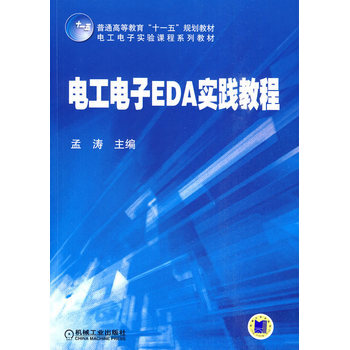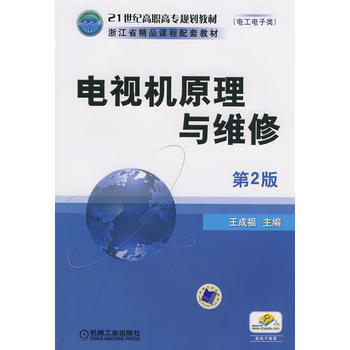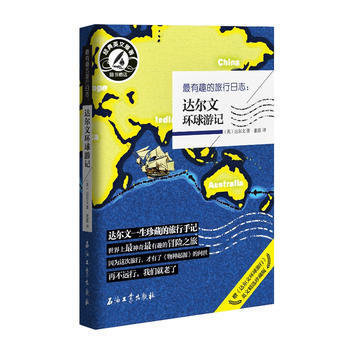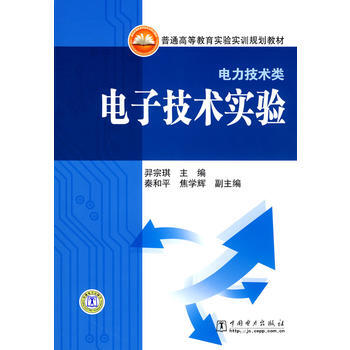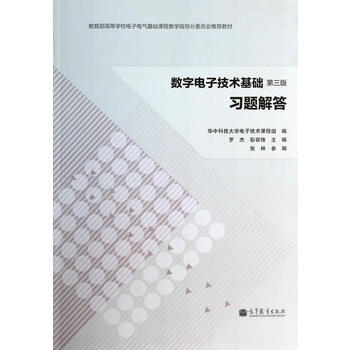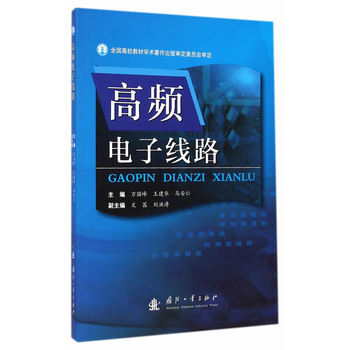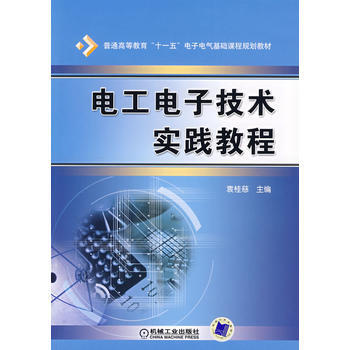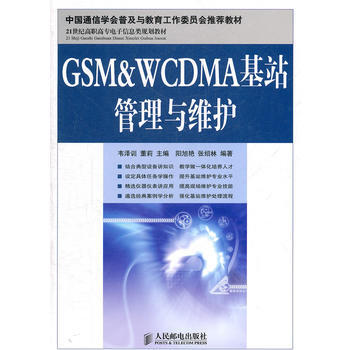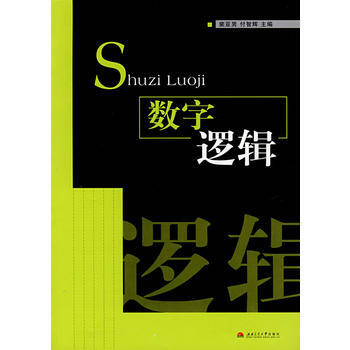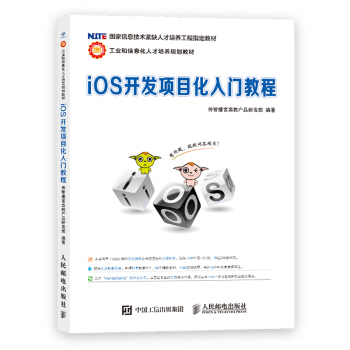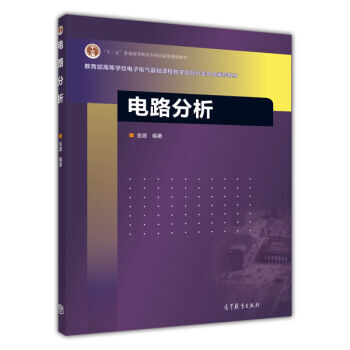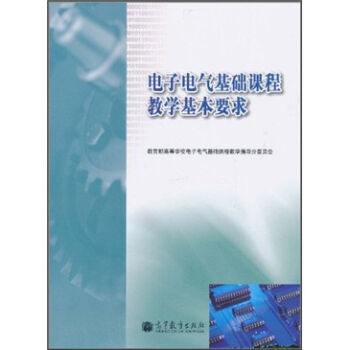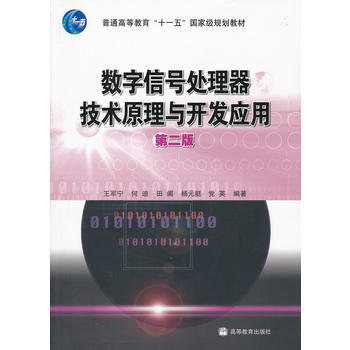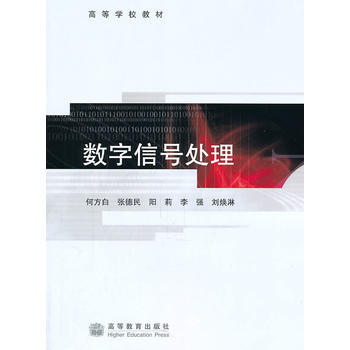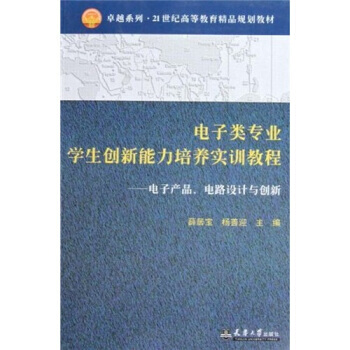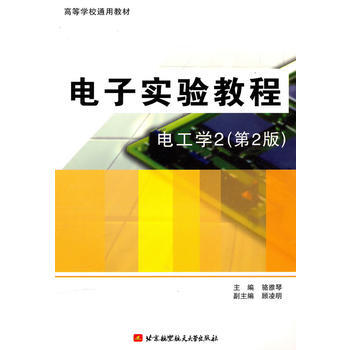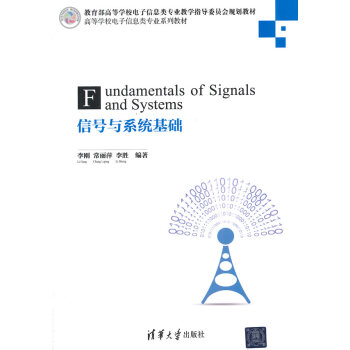

具体描述
基本信息
书名:信号与系统基础(高等学校电子信息类专业系列教材)
定价:36.0元
售价:24.5元,便宜11.5元,折扣68
作者:李刚,常丽萍,李胜著
出版社:清华大学出版社
出版日期:2015-01-01
ISBN:9787302385981
字数:405000
页码:
版次:1
装帧:平装
开本:16开
商品重量:0.4kg
编辑推荐
“信号与系统”是包括电气工程、电子信息工程、通信工程和自动化等本科专业重要的专业基础课程之一。本教材对应于全国双语示范课程。作者结合多年在国内外的教学经验及心得,针对当前双语教学及全英文教学现状,着眼于学生自学能力的培养和分析问题能力的提高,编写了本书。
本书侧重培养学生分析问题的能力及注重研究问题方法的学习。与现有同类中英文教材相比:
(1)文字精炼,内容安排上采用模拟-离散双域交替的方式。
(2)在处理常系数线性微分(差分)方程及由其描述的线性时不变系统及与变换的关系上有独到之处。
(3)知识体系完整,系统及逻辑性强,同时也适用于自学。
本教材教辅资源完整,可到清华大学出版社网站本书页面下载。内容提要
Fundamentals of Signals and Systems deals with the concepts of signals and systems, which are the corner-stone of a wide variety of areas ranging from home-oriented consumer electronics and multimedia entertainment products to sophisticated munications, aeronautics and astronautics, and control. A course on signals and systems is fundamental and pulsory for an engineering under-graduate curriculum in any well-established tertiary (education) institutions. This book provides readers with the basic principles and methods underlying the analysis of signals and systems in the context of both continuous- and discrete-time, including Fourier analysis based representations for signals and both time- and transform-domain approaches as well as state-space approach to (linear time-invariant) systems. Great emphasis is placed on being concise, easy for self-study, and rigorous. Compared with most of the existing textbooks on the same topics, more effort is made in this book to provide a clear picture of the relationship between linear constant differential/difference equations and linear time-invariant systems. Another significant feature of this book is a separated chapter (Chapter 8) that contains a set of prehensive exercises, each of which usually involves mathematical deviations and more sophisticated application of the concepts and approaches provided in the entire text book rather than an individual chapter. This book is primarily designed for undergraduate students majoring electrical & electronics and information engineering, the concepts and techniques introduced in the book, however, are of fundamental importance in all other engineering disciplines. Readers of this book are assumed to have a basic background in engineering mathematics, including calculus, plex functions, and linear differential equations. Some knowledge on circuit theory, though not a prerequisite, would be helpful for the study.
目录
作者介绍
李刚 教授,博士生导师,浙江省“钱江学者”特聘教授。1982年1月毕业于北京工业学院(现北京理工大学), 1990年11月获比利时新鲁汶大学工学博士。 1992年4月至2007年2月在新加坡南洋理工大学任教。 长期从事数字信号处理、系统与控制理论等方面的教学与研究。 主要研究方向为信号变换与压缩、数字系统结构与参数化理论及优化方法。
常丽萍 博士,副教授,2008年6月毕业于中国科学院上海光学精密机械研究所,目前在浙江工业大学信息工程学院从事教学和科研工作。研究方向为信号稀疏表示模型、压缩感知与信号检测等。
李胜 博士,讲师,2010年12月取得英国约克大学博士学位,曾获约克大学授予的K. M. Stott科研奖,于2011年10月在德国伊尔梅瑙工业大学通信研究实验室结束博士后工作。目前在浙江工业大学任教。主要研究方向包括自适应算法、无线通信系统、通信接收机设计、干扰消除等。
文摘
序言
Preface
Theconcepts of signals and systems are the corner-stone of a wide variety ofareas, ranging from home-oriented consumer electronics and multimediaentertainment products to sophisticated munications, aeronautics andastronautics, and control. The ideas and approaches associated with theseconcepts have great e.ects on our life in one way or another. Although thesignals and systems which arise across those .elds are naturally di.erent intheir physical make-up and application, the principles and tools for analyzingsignals and systems are the same and hence applicable to all of them.Therefore, an introductory course on signals and systems is fundamental andpulsory for an engineering under-graduate curriculum in any well-establishedtertiary (education) institutions. Such a course is monly designed in one ofthe two forms below:
. aone-semester subject that intends to provide students with a rich set ofconcepts and tools for analyzing deterministic signals and an important classof systems known as linear time-invariant systems;
. atwo-semester subject that expands on the one-semester course by adding moredetailed treatment of signal processing and systems for speci.ed applicationssuch as munications, multimedia signal processing and control engineering.
Thisbook takes the .rst form and assumes that the students have a background incalculus and introductory physics.
Whyanother “Signals and Systems”
Giventhat there are many well-written textbooks on signals and systems available,our readers would be screaming when seeing this textbook: Why another “Signalsand Systems”
Thethought of writing such a textbook was stimulated in 2007 when the .rst authorconducted a 2nd year course on signals and systems in Zhejiang University ofTechnology (ZJUT) in Hangzhou, which he just joined from Nanyang TechnologicalUniversity (NTU), Republic of Singapore. The course was designed as ¡°shuang yuke¡± spelled in Chinese, meaning that the teaching materials such as thetextbooks and slides are all in English and as to the class language, thelecturers can choose either Chinese, English or a mixture of the two¡ªa typicalChinese style! The textbooks adopted were those popularly used in the world butwere found very di.cult to most of our students as their English is not goodenough to deal with those textbooks of one thousand pages or so in length.1This motivates him to write a new “Signals and Systems”
Here,we have those big masters of Signals and Systems to “blame” why not writingtheir text-book in Chinese!
with aprimary objective of providing a condensed version of “Signals and Systems”in English, while keeping the important technical materials as much aspossible.
Mostof us agree that for a university study it is more important to teach studentshow to learn and analyze than what to be learned and analyzed. The .rst authorstill remembers what was said by Professor Y. Liu who taught him calculus in1978 in Beijing Institute of Technology (BIT) (now, known as Bei Li Gong) thata good textbook, say of ten chapters, should be written in such a way thatafter the .rst four chapters taught by the lecturer, the rest can be studied bystudents themselves easily. What Prof. Liu really meant is that a textbookshould be written to facilitate and reinforce self-study. This is anotherobjective that this textbook is intended to achieve. Given the mathematicalnature of this subject, rigidity should be sustained as much as possible, whichis something very important to engineering students to learn. This is the thirdobjective of this textbook.
Howthe book is structured
One ofthe reasons for the existing textbooks of signals and systems to have easilyover eight hundred pages is due to the continuous-and discrete-time forms ofsignals and systems. The success of a signals and systems that achieves ourprimary object lies in how to provide a balanced and integrated treatment ofthe two forms in a pedagogical way that can help students see the fundamental similaritiesand di.erences between the two without too much repeating. With all of these inmind, this book is organized as follow.
. Chapter 1 is aimed to provide an overview ofsignals and systems. Compared with the one in most of the signals and systems,it is condensed with an emphasis on the periodical signals and lineartime-invariant (LTI) systems.
. Chapter 2 deals with the time-domain approachto the LTI systems. Since the key to the development of this chapter is toexploit the properties of linearity and time-invariance as well as signaldepositions, the concepts of unit impulse re-sponse and convolution aredeveloped in details for the discrete-time case, while the continuous-timecounterparts are directly given. One of the remarkable points emphasized inthis chapter is the equivalence between the LTI systems and con-volutions,which relates the physical interpretation and mathematical expression. Anotherimportant technical point in this chapter is the establishment of a con-clusionwhich states that any plete solution of a linear constant coe.cientdi.erential/di.erence equation (LCCDE) can be characterized by the sum of theoutput of an LTI system excited by the force signal and a homogeneous solutionof the LCCDE. This conclusion yields a very clear picture of the relationshipbe-tween an LCCDE and the systems that it can characterize. With the help ofthe transformsto be discussed in Chapter 6, it also provides an easy way to .nd a particularsolution and hence the set of plete solutions of the LCCDE.
. Chapter3 is the biggest chapter, dealing with four signal representations, namely,Fourier series (FS), discrete-time FS (DTFS), Fourier transform (FT), anddiscrete-time FT (DTFT). The most important concept in this chapter is signalde-position. Along this line, the four signal transforms can be uni.ed as alinear bination of basis signals. This uni.cation allows us to condense thetext sig-ni.cantly as one can just focus on the development and the properties ofFT and DTFT. Great e.ort has been made to explain why a signal should betransformed, which is one of the di.cult points for most of the 2nd yearstudents to understand given that they usually do not have a relevantbackground.
. Equippedwith Chapters 1~C3, a top student should be able to study on ones own the restof this book, including Chapter 4 that studies the class of LTI systems usingFourier analysis techniques developed in Chapter 3. The key points of thechapter are the frequency response and the equivalence between convolution intime-domain and multiplication in frequency-domain and the development of theconcepts in both continuous-and discrete-time domains are rotated to avoidun-necessary repetition.
. Chapter5 mainly focuses on discrete processing of continuous-time signals. Thedevelopment .ows mainly from the techniques derived in Chapters 2¨C4. Startingfrom sampling a signal that is continuous in time-domain, the relationshipbetween the spectrum of the continuous-time signal and that of thediscrete-time signal obtained is established, based on which the famoussampling theorem and hence the ideal reconstruction can be derived. Unlike mostof the existing textbooks, this relation is derived directly using a simplemathematical procedure rather than the one that is obtained with the help ofimpulse train. Note that the DTFT of a discrete-time signal is a continuousfunction in frequency. Sampling (in frequency) of such a function leads to anew transform-discrete Fourier transform (DFT) that is popularly used in manyapplications of digital signal processing, including linear .ltering,correlation analysis, and spectral analysis. More profound discussions on theDFT, however, are beyond the scope of this book as the relevant topics areparts of the core contents for the subjects on digital signal processing.
. Chapter6 deals with transform-domain approaches to signals and systems. The Laplacetransform and z-transform are studied in a parallel way, while the appli-cationsof the two transforms to LTI systems and .nding the plete solution of anLCCDE are given in a uni.ed manner, which once again allows us to condense thetextbook. As two of the new features of this book, the problems of .ndinginverse systems of a given LTI system & de-convolutions and deposingsystem responsesare carefully treated. The former is rarely found in most of the existingtextbooks, while the latter is intended organized to help students have an easyunderstanding of the unilateral transforms.
. The advantage of the uni.ed/integratedtreatment of the continuous-and discrete-time forms is particularlydemonstrated in Chapter 7 in study of block-diagram representations andstructures of the LTI systems in transform-domain. As a special class of systemstructures, the state-space realizations of LTI systems are introduced.
. Following the traditional pedagogy, thetutorial questions given in each chapter are mainly designed for helpingstudents to enhance the understanding of the concepts in an individual chapteronly. This, however, would make most of the students problem-result-orientedand hence loses the real purpose of learning. To overe this, Chapter 8 isdevoted to providing a set of prehensive exercises, each of which usuallyinvolves mathematical deviations and a more sophisticated applica-tion of theconcepts and approaches provided in the entire text book rather than anindividual chapter.
. Appendices are used to make the book conciseand self-contained, and also sustain rigidity of the development.
Acknowledgements
It isour great pleasure to thank a number of people who helped us in writing thisbook with insightful suggestions and constructive feedback and those who didnothing directly to this book but we just feel good in doing so.
GangLi is grateful to his former NTU colleagues, particularly, G.A. Bi, C.R. Wan,
Z.P.Lin, Y.C. Lim, L.H. Xie, and W.J. Cai for insightful suggestions, constructivedis-cussions, and more importantly, the friendship. M.Y. Fu of the Universityof Newcastle (Australia), S. Chen of the University of Southampton (UK), J. Wuof Zhejiang Univer-sity, and Y.Q. Shi of the New Jersey Institute of Technology(USA) have shown their continuous support to Gang Li¡¯s work in ZJUT, which isvery much appreciated. He would like to take this opportunity to thank the mostimportant person to his academic career¡ªMichel Gevers of the Universit¡äeCatholique de Louvain (UCL) (Belgium), who was his Ph.D supervisor and taughthim so much, particularly on how to write. This book es true partially owingto the adventure they had together in writing their co-authored book¡°Parametrizations in Control, Estimation and Filtering Problems: AccuracyAspects¡± published by Springer-Verlag (London limited, 1993). Un Grand Mercy,Mig !
LipingChang is grateful to her Ph.D supervisor, academician Z.Q. Lin, SIOM of ChineseAcademy of Science, Shanghai, who taught her how to explore and solve scienti.cproblems during her graduate period.
ShengLi wants to say ¡®thank you for bring me to this field¡¯ to his Ph.Dsupervisor, Rodrigo C. de Lamare (Reader), University of York, U.K.. Inaddition, he is grateful to his ¡®boss¡¯ during his post-doctorial work, MartinHaardt (Professor), TU-Ilmenau, Germany. Both of these nice guys taught himmany things and helped him to improve himself.
All ofus would like to express our gratitude to many colleagues in the College ofInformation Engineering of ZJUT. Particularly, X.X. He, Y.L. Qin and S.Q. Guoare acknowledged for their full supports in various ways. It is really ourpleasure to work with them and to have achieved something meaningful together.The contribu-tion of other members in the teaching team for the subject¡°Signals and Systems¡± is acknowledged. It was due to a great collective e.ortsuch that this subject was horned as a National Model Course in English by theChinese Ministry of Education and a Provincial Course of Excellency by theEducation Board of Zhejiang province. Par-ticularly, Tao Wu¡¯s contribution andthe support from the Academic Affairs Of.ce of ZJUT as well as the two projectsare very much appreciated. It is also our pleasure to acknowledge the authorsof many existing textbooks on signals and systems pub-lished in English andChinese since their works have influenced our book in one way or another.
Wethank many students who made contributions to this book with suggestions andquestions that helped us over years to re.ne and rethink the organization andpresentation of the materials in the book. Particularly, we would like to thankChaogeng Huang, who has just obtained his Ph.D under the guidance of the 1stauthor, and Huang Bai for the excellent job done in terms of research andadministration, and two very talent undergraduate students (Year 2007) Yue Wangand Dehui Yang who helped us with simulations, .gures and tutorial problems.Special thanks go to our teaching assistants Zhihui Zhu, Tao Hong, Qiuwei Li,Shuang Li, and Liang Zhu for their help in preparing tutorial solutions andsome of the puter experiments. We are grateful to our students for theiractive participation and intensive interaction with us, which makes this bookeven more student-oriented.
Wewould like to take this opportunity to thank Professor Xianyi Gong, a Fellow ofthe Chinese Academy of Engineering, of Zhejiang university for sharing with ushis insightful views on signal processing (SP) as well as many other issues. Itis our pleasure to say that his understanding and conception of SP as well asthe enthusiasm to education have great influence on us!
Lastly,we would like to thank the support from our families, which is the drivingforce for us to write this book. It may be felt unusual by those not close toGang Li that the .rst one among his family members to mention is hisbrother-in-law Aiguo Li who has done everything possible for him and hisfamily. Liping Chang wishes to thank her family members, particularly herhusband Jia Li and their four-month old son for their deep love. Sheng Li hasthe pleasure to say ¡°I love you much more than myself ¡± to his darling wifeXiaolei Zhang and his parents.
GangLi (ieligang@zjut.edu.)
Liping Chang (clping@zjut.edu.)
Sheng Li (shengli@zjut.edu.)
July 01, 2014
at Xiao He Shan, Hangzhou
用户评价
坦率地说,市面上的很多教科书,要不是过于偏向数学推导而牺牲了直观理解,要不就是过于注重工程应用而忽略了背后的理论根基,但这本书在两者之间找到了一个近乎完美的平衡点。 举例来说,在讲解Z变换时,它不仅仅停留在代数运算层面,而是巧妙地引入了收敛域(ROC)的概念,并且清晰地解释了ROC是如何决定一个系统因果性、稳定性的关键因素。这种将数学工具与系统特性紧密结合的教学方法,彻底改变了我对“系统分析”的看法——它不再是枯燥的代数游戏,而是对物理世界运行规律的精确描述。再者,书中对各种滤波器的介绍,如巴特沃斯、切比雪夫等,虽然篇幅适中,但对它们的设计哲学和性能折衷(如通带纹波与过渡带陡峭度的权衡)的剖析极为精辟。这让我明白,设计一个滤波器不是随便画个曲线就行,而是一个充满智慧的取舍过程。这本书的深度足以支撑本科生未来进入研究生阶段的学习,其内容的广度也能覆盖电子信息类专业绝大多数方向的基础要求。
评分我曾向一位在工业界工作多年的前辈请教关于系统建模的最佳入门教材,他毫不犹豫地推荐了这本,现在我完全理解了他的选择。 这本书最打动我的地方在于它的“工具箱”思维。它没有将各种分析工具(如卷积、傅里叶、Z变换)视为孤立的知识点,而是像提供一套精密工具箱一样,告诉你什么时候该用哪一把扳手。例如,在处理周期信号时,傅里叶级数是首选;当需要分析非周期信号的频谱特性时,傅里叶变换登场;而一旦涉及到离散系统的因果性和稳定性判断,Z变换就成了最有力的武器。这种基于应用场景的知识组织方式,极大地增强了知识的实用性和可迁移性。此外,书中对系统框图的分析,尤其是对反馈系统和补偿器的初步介绍,虽然没有深入到控制理论的细节,但已经为后续学习搭建好了清晰的信号流向图。这本书培养的不仅是知识的掌握,更是一种结构化的问题解决能力,让我有信心去面对更复杂的现实工程问题,而不仅仅是应付考试。
评分说实话,初接触这门课的时候,我感觉内容庞大得有点让人望而生畏,直到我接触到这本教材,才真正体会到什么叫“化繁为简,深入浅出”。 它的排版设计也值得称赞,图文并茂,很多复杂的系统框图和波形图都画得非常清晰直观,这对于我们这种视觉学习者来说太重要了。我特别喜欢它在讲解卷积积分那一章节的处理方式。很多教材对卷积的解释都是一笔带过,导致我们只能死记硬背公式,但这本书却用了一个非常形象的“滑动叠加”的物理过程来解释,甚至还配上了动画效果的示意图(虽然是静态的,但描述得让人浮想联翩),让我对这个核心概念有了非常直观的理解。此外,书中对LTI(线性时不变)系统的分析,从时域到频域的变换路径设计得极其平滑,每一步都有明确的数学依据和物理意义的支撑,让人感觉每一步推导都是水到渠成的。这本书的语言风格是那种非常严谨的学术范,但又带着一股温和的引导性,不像有些教材那样冷冰冰的,读起来让人感觉像是在听一位经验丰富、耐心细致的教授在为你讲解,非常舒服。
评分我必须承认,在学习过程中,我曾被一些更花哨、更注重前沿技术的资料所吸引,但最终发现,万变不离其宗,所有的“新奇”技术都建立在坚实的“基础”之上,而这本教材就是那个最坚实的基石。 它对傅里叶变换和拉普拉斯变换的区分与联系,处理得极其到位。很多时候,我们容易将两者混淆,但这本书通过对比它们各自适用的信号范围和变换的物理含义,清晰地划清了界限,并强调了它们在系统分析中的互补作用。我尤其欣赏它对采样定理的讨论。不只是给出那个$f_s > 2f_{max}$的公式,它还深入分析了欠采样导致的混叠现象的后果,甚至用了一个很小的篇幅介绍了如何通过合适的插值滤波器来重建信号,这种前瞻性的视角,让初学者也能感受到信号处理的“工程之美”。这本书的逻辑架构非常严谨,它不会让你在学完A后立刻跳到Z,而是确保你完全掌握了B和C,才会带你去看更复杂的D。对于自学者来说,这种“步步为营”的教学法,极大地降低了学习曲线的陡峭程度,让人有持续探索下去的动力。
评分这套教材的理论深度和应用广度简直是为我们这些初入电子信息领域的学生量身定做的,尤其是对那些想打下扎实基础的同学来说,简直是不可多得的宝藏。 我记得第一次翻开这本书的时候,就被它清晰的脉络和循序渐进的讲解方式所吸引。它不像有些参考书那样上来就堆砌公式,而是通过大量的实例和生活化的场景来解释那些抽象的信号处理概念。比如,讲解傅里叶级数的时候,它不是简单地告诉你那个积分公式怎么用,而是会用声波、光波的周期性来类比,让你瞬间理解为什么需要将一个复杂的信号分解成一系列简单的正弦波。更让我印象深刻的是,它在介绍连续时间系统和离散时间系统的转换时,处理得非常巧妙。作者似乎深谙我们这些初学者的思维定式,总能在关键的转折点给出恰到好处的解释,避免了陷入“黑洞”。这本书的习题设计也很有水平,从基础的计算题到需要综合运用多个知识点的分析题,层次分明,保证了我们不仅仅是“看懂了”,而是真正能“做出来”。对于想深入研究通信、控制或者图像处理方向的同学来说,这本书绝对是打地基的首选,能让你在后续的学习中少走很多弯路,建立起对整个电子信息领域的宏观认知框架。
相关图书
本站所有内容均为互联网搜索引擎提供的公开搜索信息,本站不存储任何数据与内容,任何内容与数据均与本站无关,如有需要请联系相关搜索引擎包括但不限于百度,google,bing,sogou 等
© 2025 book.idnshop.cc All Rights Reserved. 静思书屋 版权所有

